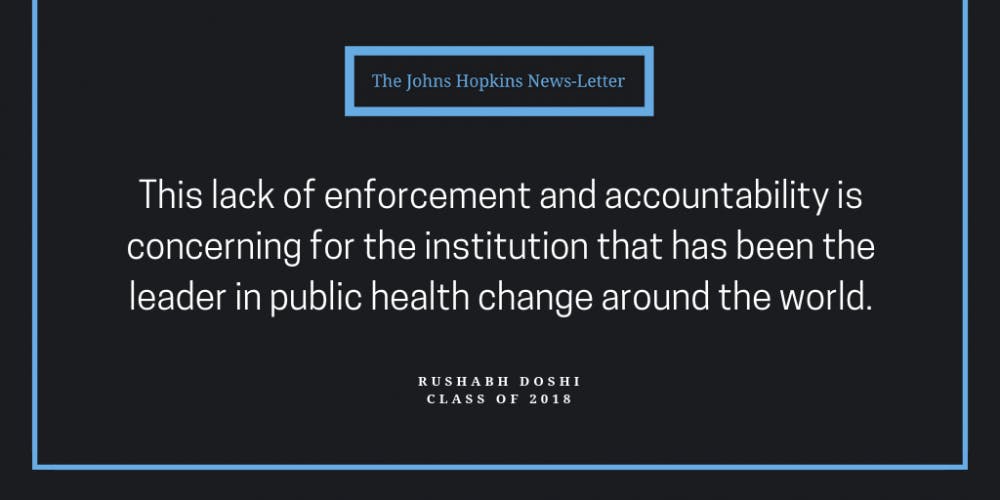That smoking jeopardizes everyone’s health has been well-known for decades. In fact, Hopkins faculty have produced much of the research detailing smoking’s deleterious effects. Ironically, it is the University’s smoking policies that lag behind those of its peer institutions.
The Homewood Campus follows an outdated and ineffective smoking policy. The current smoking policy states that any tobacco products “are prohibited in all Hopkins buildings, except for specifically designated smoking areas.”
It continues, saying that “there are designated smoking areas exterior to Hopkins buildings which are identified by signage.” But the signs are often vague.
While buildings like the Brody Learning Commons prohibit smoking within 25 feet, Garland Hall bars smoking “in this area” without specifying what “this area” constitutes. Shaffer Hall’s signage merely says not to smoke in the building, and many buildings seem to lack signage all together.
In terms of enforcement of this policy, students, staff and faculty are all confused as to who is tasked to enact the “disciplinary action, which may include fines,” warranted by existing University policy. In the absence of practical enforcement procedures and awareness initiatives, many Hopkins employees are unaware or uninformed of the consequences of violating the current smoking policies.
This lack of enforcement and accountability is concerning for the institution that has been the leader in public health change around the world.
Administrators and health service-related staff members on campus seem receptive to a smoke-free campus and want to hear the student body’s thoughts on developing a uniform tobacco-use policy for campus.
During the spring 2018 semester, the health advocacy group Hopkins Kicks Butts made a survey with the Center for Health Education and Wellness (CHEW) to gather and evaluate student opinions on a campus smoking policy.
With the help of the Student Government Association (SGA), we distributed the survey and amassed representative data from over 875 students. The data indicates that students are in favor of a comprehensive tobacco policy. Seventy-two percent of surveyed students favored restrictions on traditional tobacco usage on campus. Out of the tobacco policies that students could indicate support for, 65 percent wanted to see a completely smoke-free campus or a smoke-free campus with the exception of designated smoking areas.
The data indicates that we must act now. Our primary concern must be the overall health of the campus community.
Think of those with asthma and chronic obstructive pulmonary disease (COPD), for whom secondhand smoke can trigger life-threatening physical reactions. Think of those whose family medical history makes them more susceptible to developing cancer and other diseases from secondhand smoke. Think of the elementary and middle school students from Baltimore who come to campus, whose small lungs and bodies are even more susceptible to secondhand smoke.
This is not about forcing anybody to change their lifestyle. This is about improving the health of everyone around us and building a community that recognizes the impact of secondhand smoke on our most vulnerable; it’s about providing support and resources to those who wish to quit smoking and creating a healthier and longer-lived community for all Hopkins affiliates.
All that said, I wholeheartedly acknowledge the concerns raised about different cultural perspectives on smoking, regulation of personal behavior, and not accounting for the interests of each constituency group on campus.
Last year, however, SGA worked with the administration to ensure that if smoking zones were to be implemented, they would be supported by services for staff, students and faculty who would undergo lifestyle changes if Hopkins adopted a smoke-free campus.
We fought to ensure proper smoking cessation programs for all members of the Hopkins community and worked with the administration to only work with vendors that would also allow dependents of Hopkins affiliates to join these programs. We got feedback from all stakeholders. After gaining a lot of ground these past two years and allocating resources for those most affected by this ban, SGA, along with Hopkins Kicks Butts, has taken steps to ensure that smokers will have any and all the resources that they need to transition, while all members of the Hopkins community will be better protected from the risks of tobacco exposure.
As a pioneer in public health and medicine, the University should adopt a smoke-free campus with designated smoking areas on the Homewood Campus to protect and preserve the health, wellbeing and integrity of its community.
Rushabh Doshi, Class of 2018, was the co-president of the anti-tobacco student organization Hopkins Kicks Butts and the leader of the Smoke-Free Hopkins Initiative in SGA.





